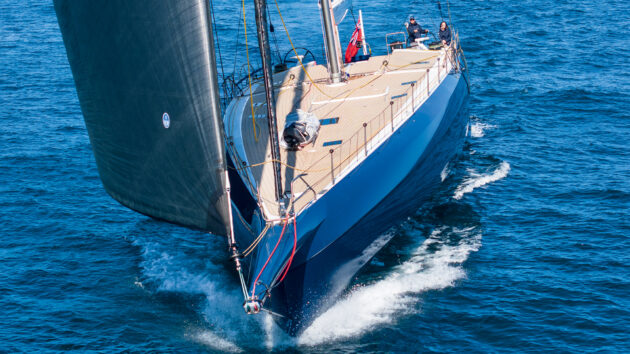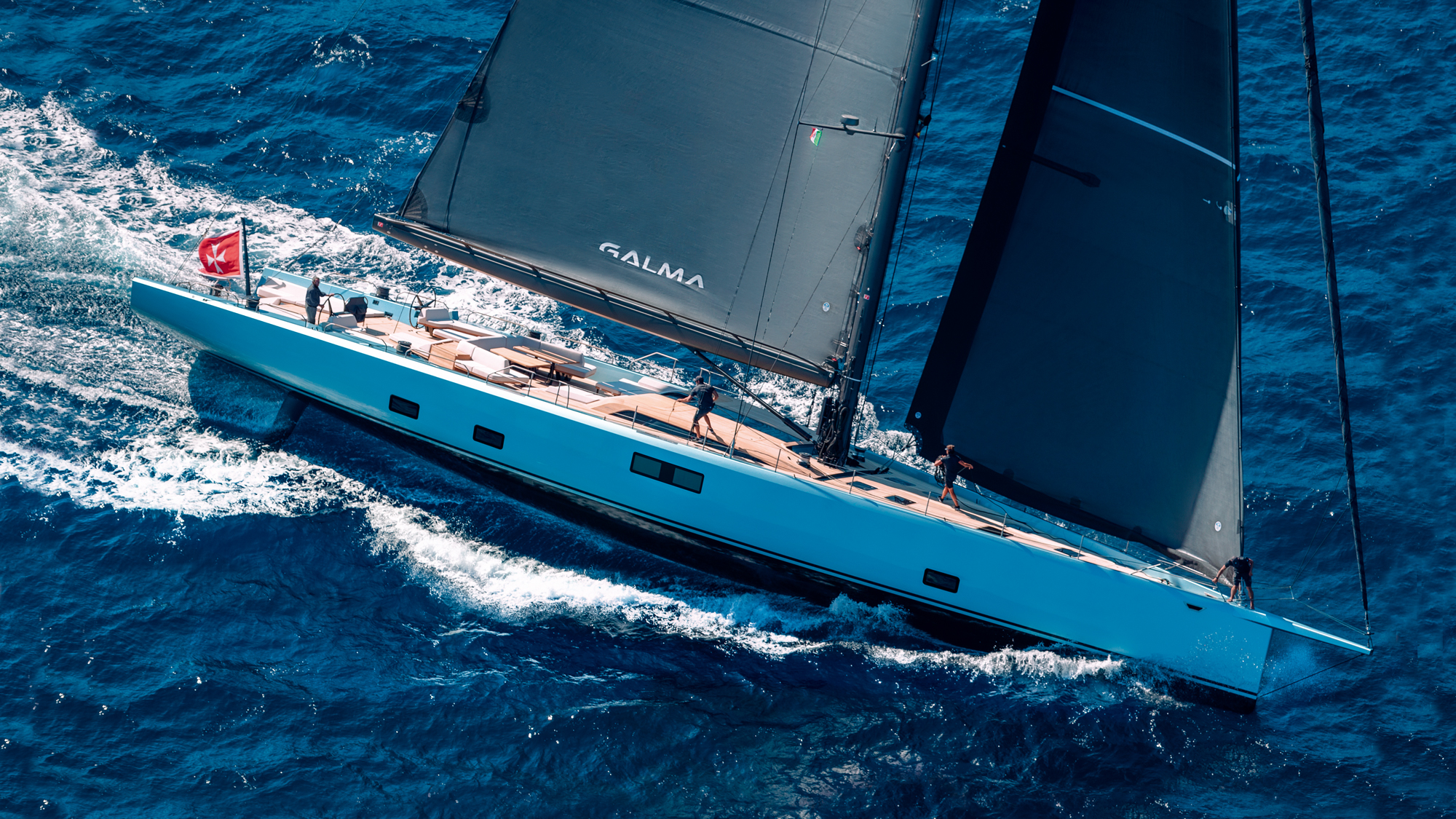A canting, lifting keel and revolutionary electric power help make Magic Carpet-e one of the lightest, most advanced Maxis yet. Matthew Sheahan spent two days aboard the Verdier-designed Magic Carpet-E
Magic Carpet-e review: Sailing the first fully electric racing Maxi to be launched
Sir Lindsay Owen-Jones didn’t want a new boat, yet today not only has he a shiny new state of the art 100-footer, but a machine described by some as the most advanced Maxi to be launched in more than a decade. And at the new boat’s first competitive outing on the first day of racing at this year’s PalmaVela regatta Magic Carpet-e won the first two races.
To say that her build happened by accident would be an exaggeration, yet the genesis of what has turned out to be such an advanced and promising new Maxi didn’t start with a set of clear objectives and well-defined goals.
Having been built pretty much in secret by Persico Marine in Italy and pre-launched discretely last autumn, (before being taken back into the shed to be completed for a re-launch this spring), the new Carpet is in flight and the details of this new design are now being revealed.
On the face of it, while she may look like a sleeker, leaner version of others in her class, the basic data has her standing out from the off.
Here the displacement is the headline figure. At 37 tonnes she’s a staggering 10 tonnes lighter than the previous Magic Carpet, a Wally Cento Maxi that herself was never considered to be overweight.
The new Carpet also sets an impressive amount of sail on a rig that looks more IMOCA 60 than Maxi, while below the waterline she sports what must surely be the most sophisticated appendage package of any current Maxi.
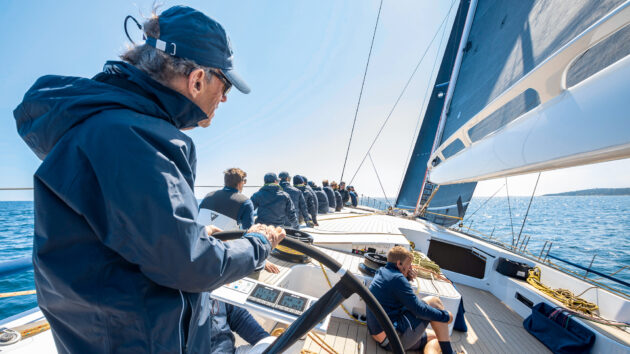
The flush deck and minimalist appearance of a cockpit that has just six winches, belies the advanced technology and sophistication which lies below. Photo: Francesco Ferri
And then there’s her power plant. While she does have a comparatively small and potentially removable generator for delivery trips, this is the first fully electric racing Maxi to be launched, armed with technology that has its roots in high end motorsport and that could prove to be a catalyst for development across broad areas of sailing, both for racing and cruising.
In simple terms, she has the equivalent of three Golf GTIs below deck delivering a stream of silent power that is available at the touch of a button for the crew on deck.
The bottom line is that right from the start, and despite just a cursory look at her headline features, Magic Carpet-e is far more than just another new race boat. Which begs one simple question to start: how did Sir Lindsay Owen-Jones end up with such an advanced new boat when he didn’t want one?
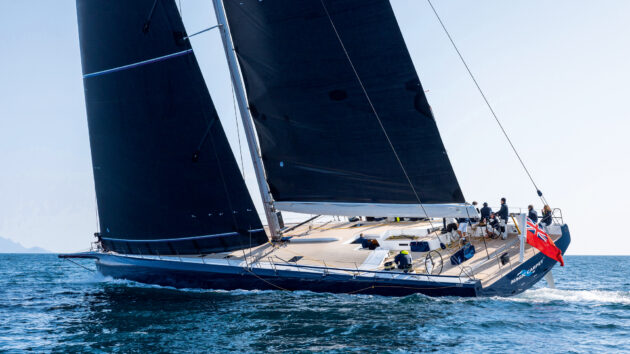
Photo: Francesco Ferri
Taking the next step
Having raced and cruised Magic Carpet Cubed, as she was nicknamed, for 12 years, the rhythm of his boat ownership suggested that it might be time for an upgrade. The trouble was, that as a hands-on owner who’d always enjoyed the process of developing a new boat as much as the racing and cruising, he couldn’t really see where to go next.
“You hesitate before you start any new build of this size – it’s a long and expensive process,” he explained. “Over the years as we moved from Magic Carpet one to two and three, we’ve always had new objectives in mind. Not long after launching Magic Carpet Cubed, I was already thinking of what the next step was going to be and while we kept improving and refining, I could see what we could do slightly better, but not much better.
“And then somebody introduced me to designer Guillaume Verdier who said he could do a boat like mine 10 tonnes lighter and that it would ‘go like a rocket.’
“I thought it was worth a try and so we started talking.”
As the chief architect behind some of the world’s fastest and most radical racing designs it was a given that Verdier’s ideas would be ‘out there’.
Article continues below…
Can battery powered boats really be called sailing boats? – Matt Sheahan
If you ride an e-bike you’ll be used to being called a cheat. You’ll also be familiar with the way…
Wallywind 110 review: ‘I’ve never ticked off stretches of coastline so effortlessly’
There are very few times I feel the need to video the scene from a day on the water simply…
“When Sir Lindsay gave me the first brief he told me to draw what I wanted within 100ft,” said the French designer. “So, my first design looked at foiling and while Sir Lindsay liked the idea of taking performance onto another level, he said there were some key objectives in addition to being competitive in the Maxi class, which meant that this was too extreme for him. Instead, he wanted to be able to sail with friends, plus the boat needed to be capable and comfortable for cruising short-handed.”
Living in St Tropez, Sir Lindsay’s racing and cruising has always been primarily in Europe. And with the Maxi racing scene both growing and focussing more on this area, a yacht concentrated on Mediterranean conditions ticked many of the boxes on the competitive front. This, in turn, led to a target optimum wind speed range of 8-12 knots. And from here the first key design objective was to be the fastest Maxi in these conditions.
“When the goal is to perform well in 8-12 knots of wind, the reality is that you have to be very good in 7-8 knots,” said Verdier. “To sail in light conditions, boats need to be able to perform in much lighter winds. At critical periods when you slow down through manoeuvres like tacks and gybes it’ll be hard to accelerate, especially if you have a lot of wetted surface area. So, the performance objectives are actually more demanding if you’re focussing on good performance in 8-12 knots of breeze. This was one of the factors that drove us towards the high aspect ratio rig.”
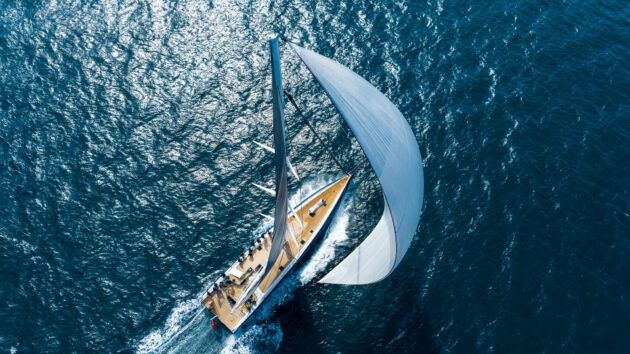
‘This is the first fully electric racing Maxi to be launched’. Photo: Francesco Ferri
The result is a sail plan that towers 46m above the waterline and sits well back in the boat. This achieves a long foot length (J measurement) for the biggest headsail, and provides scope for a range of furling headsail systems.
Stepping the mast on deck, rather than on the keel, meant the rig could not only create a large foretriangle, but also set it over the canard and just in front of the keel to achieve better balance.
Remarkable appendages
A large, efficient sail plan and a low wetted surface area provided by slender waterlines were important, as was generating high amounts of righting moment – which led to a canting keel that swings to 45° on either side.
But this is a canting keel with a big difference.
Getting into favourite harbours and anchorages, including Magic Carpet’s home in St Tropez, was essential, which meant a lifting keel was required. But the design team knew that lifting a fin and bulb keel to reduce draught from 7.1m to 4.6m vertically in the established way would result in a heavy structure and a vertical centre of gravity that would be higher than they’d like.
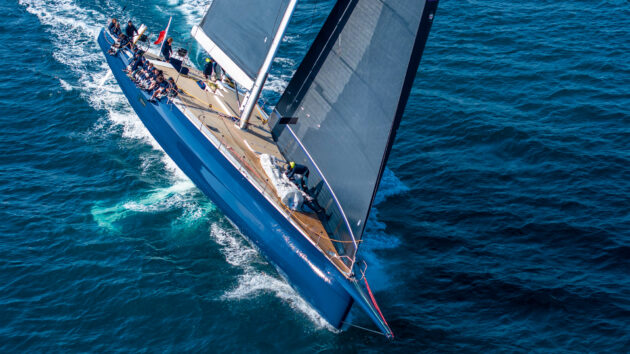
Canting keel and canard can be clearly seen here. Photo: Francesco Ferri
The solution was to reduce draught by raking the keel 60° aft like a dinghy centreboard, but where the keel bulb would remain parallel to the water as it was swung aft.
The engineering is not just fascinating in a system that can reduce its draught in just two minutes, but is a thing of beauty down below. So much so that the primary keel support structure, which has been milled out of two giant billets of titanium, has been not so much enclosed, but displayed in a wet box that looks more like a museum showcase complete with lights.
“It certainly was a big deal building this system,” explained project manager Ed Bell. “We had to pre-order the titanium billet before any work started on building the boat.”
Under sail, with the keel out to one side, and in contrast to IMOCAs and many other canting keel boats, Magic Carpet generates her hydrodynamic side force using a single canard mounted on the centreline. The reason is simple, one foil is lighter than two, but that’s the only part that is simple.
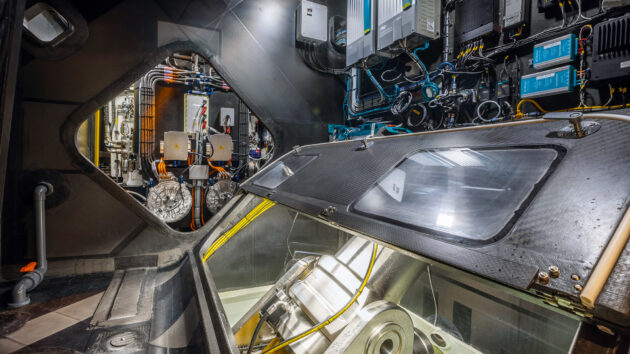
Like a museum display. Canting keel support also allows the fin and bulb to retract like a centreboard. Photo: Francesco Ferri
The foil is a symmetrical section, rotates to generate lateral lift and can be raised or lowered. What’s different is that this canard also cants to allow the foil to run as close to vertical as possible when the boat is heeled.
Like all canards and lifting surfaces, get the settings right and they can be powerful devices, get the settings wrong and it’s easy to put the handbrake on too. So, to have a foil that lifts, rotates and cants while generating the side force for a 37-tonne beast of a boat is an engineering challenge; it’s not that surprising that the team are rather coy when it comes to revealing how they actually achieve and control this.
But when it comes to their innovative twin rudder system they’re more open. Verdier was initially keen to have kick-up rudders to allow the windward one to be lifted to reduce drag, especially upwind, but this was not considered practical aboard a boat that will spend plenty of time moored stern-to. Instead, Magic Carpet-e has daggerboard-style rudders mounted in rotating barrels. When they lift they come through the cockpit sole.
Aside from the reduced drag of this configuration (which I’m led to believe was originally developed 30 years ago and patented by Kullmann Design as the VarioRudder), one of the key advantages is providing a robust and watertight arrangement when compared to a conventional rudder stock and bearing system.
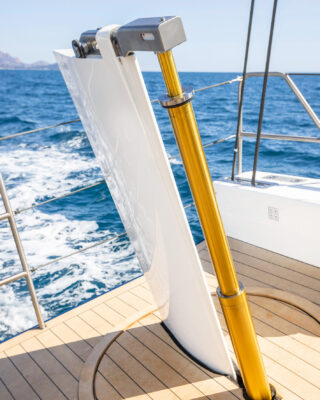
Twin rudders operate in rotating cassettes where the blades can be raised and lowered hydraulically. Photo: Francesco Ferri
The real innovation
Meanwhile, in parallel to the development of this super slippery Maxi another idea became a central and highly innovative feature of the boat, that took Sir Lindsay and his team far deeper into a new world of Maxis than any of them had originally expected – electric power.
The system allows the boat to be raced all day, including leaving and returning to the dock, on electric power alone. This might not sound like a huge challenge, but when you’re talking about a 100-footer designed for round-the-cans racing, where hoists and drops happen faster than on a fully crewed 40-footer and the line speeds in the pit are up to 5m/second, that’s a lot of power!
Indeed, race aboard any of the current Maxis with their diesel generators that provide electric and hydraulic power for sail control areas and you are left in no doubt as to the power that is required to get them around the course. Take a windward mark rounding. As a typical modern Maxi bears away the engine revs increase in an instant as if someone has floored the throttle at the Santa Pod drag strip.
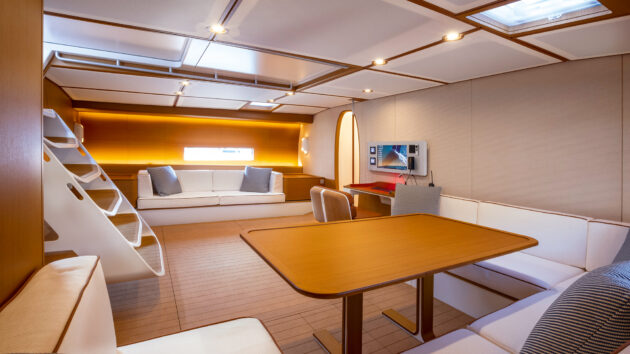
Given this is a race boat primarily, the main saloon and entire accommodation is striking. Photo: Francesco Ferri
Magic Carpet-e is different. While there’s a whining of hydraulic controls and whirring of winches, that’s it. But creating an all-electric boat, (or hybrid as they describe it), wasn’t the original goal.
“A few years before this project started, Ed Bell, (who has been involved in previous Magic Carpets) and I were driving and I’d spoken to someone on the phone who’d just seen an amazing electric motor which was tiny,” explained Magic Carpet skipper of 30 years, Danny Gallichan.
“We were chatting in the car about how good it could be if you could use them with the hydraulics and the thought stayed in both of our minds.
“Sir Lindsay is very interested in technology and has been involved in motorsport for many years and during the early development of this boat he encouraged us to take the idea further.”
This led the team to Williams Advanced Engineering, now Fortescue, who helped analyse what was needed in terms of power, energy use, and duration while also calculating how much such a system would weigh.
“We started by looking back at how many hoists, drops, tacks and gybes we’d done during various regattas over a number of years,” said Bell. “We looked at how long we had motored the boat for, along with other power demands.
“We also worked closely with hydraulics experts Cariboni to assess how much power we needed to operate the hydraulic systems through some of the most extreme scenarios and the longest days on the water. We then delivered this information to Fortescue who calculated the power we’d need to go electric.
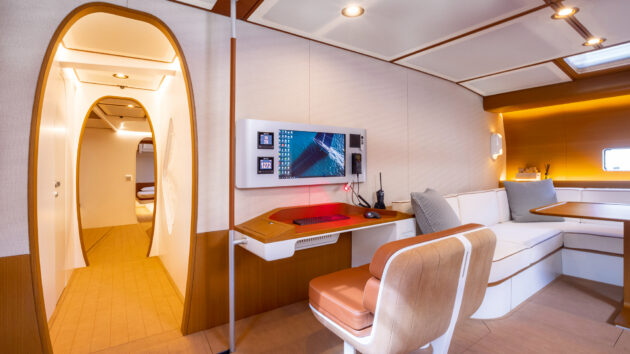
The navigation station sits on the centreline and incorporates a Hermes-designed seat. Photo: Francesco Ferri
“It was also crucially important the system was no heavier than a conventional diesel generator and preferably lighter. The results from Fortescue gave us the answer we needed to go ahead.”
When it came to creating the system, the team worked with electric motor specialists Helix to produce a battery that provides power for all the onboard systems from the winches, the propulsion system through to the air conditioning.
In short, Magic Carpet has three electric drives, two for the hydraulic system and one for propulsion.
“One of the key stages was opting for a direct drive in order to achieve the quietest operation,” said Helix’s chief innovation officer Andrew Cross. “Because these motors operate at relatively low rpm we needed a lot of torque – the hydraulic pump machines were each around 1,000Nm and the propulsion motor achieved almost 2,000Nm.
“The motors are driven by our ultra-lightweight, high-efficiency silicon-carbide inverters. Broadly speaking the motors are at similar power levels to those we supply to Formula E, but four to five times more torque. It’s like having three Golf GTIs on board.”
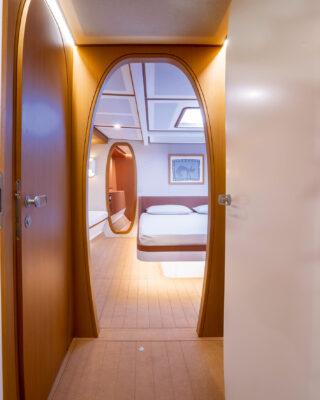
Not only are the oval apertures better structurally, they make for a lighter structure and look impressive. Photo: Francesco Ferri
On deck and underway
So, you’d think you would hear at least one of these GTIs when you left the dock. Instead, our departure from the quay in St Tropez was so quiet that we were halfway along the entrance to the harbour before I realised we had left. This is a Maxi that ghosts along.
The second surprise came when the mainsail was raised in under one minute.
But even this was tame compared to her performance under sail. On a glassy looking sea, where the 7 knots of breeze at the top of the mast had barely made its way down to the surface, we were trucking along at 10.3 knots upwind.
As conditions built to 8-12 knots of breeze we were slicing along at 12 knots upwind and up to 17 on a reach.
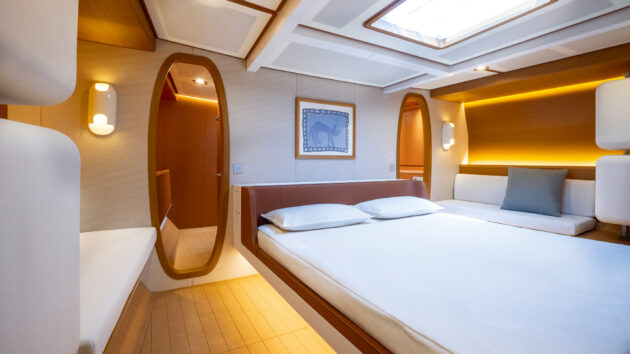
The owner’s cabin forward. Photo: Francesco Ferri
On the helm she felt completely neutral. Like many modern high-performance boats, to get into the groove you need to know the targets. But even then, just as you think you’re getting the hang of it, a change of canard angle sends the bow careering off in either direction. Even in modest conditions it’s clear how powerful this foil is.
Also impressive is the speed with which Magic Carpet can turn corners. With furling headsails on units that are recessed into the deck to allow a proper end plate effect on the headsails, big manoeuvres easily match those aboard boats half her size.
This is made all the more impressive when you consider that she has just six winches. Even her most up-to-date competitors in the Maxi scene with their hydraulic ram trim systems have eight.
“A pair of winches weighs around 120kg,” said Bell. “So, in collaboration with Cariboni and Rigging Projects we have developed a system where the running backstays can be operated mainly by hydraulic rams, dispensing with the need for dedicated runner winches.”
That’s a bold call aboard a boat with a deck-stepped mast that relies on its fore and aft support from the runners. But among the long list of advanced technology aboard this boat there is one area that is easier to admire, her looks below decks.
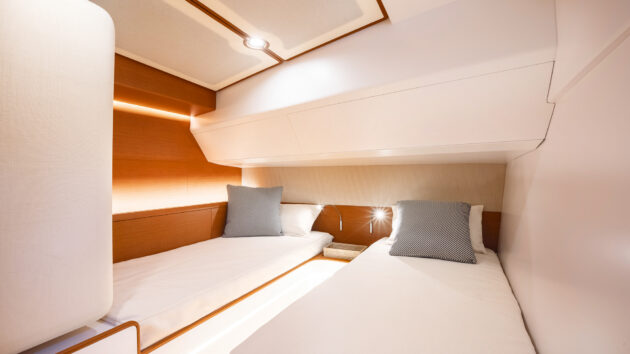
One of two guest cabins. Photo: Francesco Ferri
Cruising comforts
Cruising has always been an important part of Sir Lindsay’s season and while some Maxis claim to have been designed to allow their owner and friends to go cruising, the result is often a spartan affair.
Not so on Magic Carpet. This design was configured to be sailed short-handed, in comfort and style for the owner and guests.
“The big challenge was that we had a weight budget of just two tonnes for the entire accommodation,” said designer Axel de Beaufort. “We worked really hard to keep the weight down and used some of the natural features of the boat to accentuate the unique feel below decks.”
One example is how the wood veneer is attached directly to the inside face of the hull, emphasising the tumblehome in the topsides. Another is the use of oval cutouts in the bulkheads. These are not only structurally more efficient by reducing the stress-raising corners of square openings, but look rocket retro stylish too.
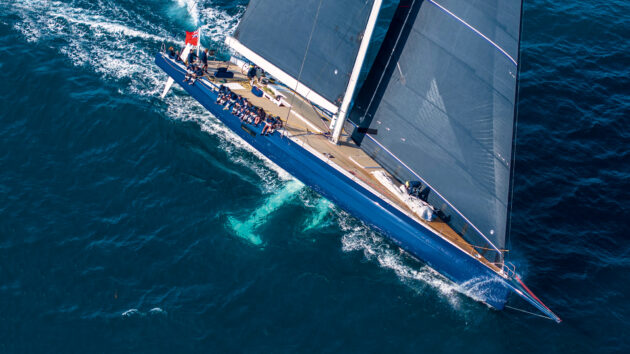
Be it tumblehome or the position of the mast, some details are more IMOCA than maxi. Photo: Francesco Ferri
The custom woven fabric used for the headliners and the cube-like lockers is another area where the team worked hard to combine looks with light weight in an interior that can be easily reconfigured for racing.
And then there’s the Hermes navigation station.
This may be a race boat most of the time but Magic Carpet-e oozes style below decks.
And that’s what makes this new Maxi stand out. The combination of innovation above and below the waterline, along with groundbreaking technology in her power system aboard a sleek looking beast of a boat is what has led several industry experts to claim that Magic Carpet-e is currently the most advanced Maxi out there.
All she has to do now is to prove it.
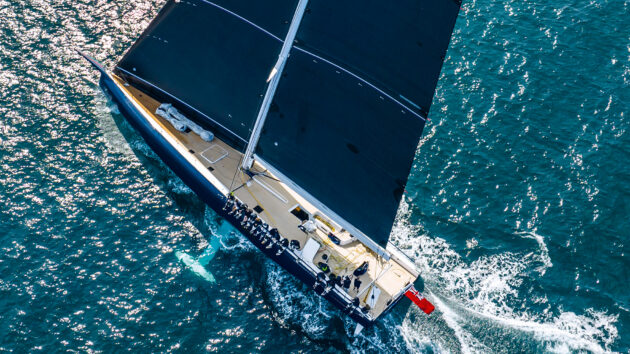
The high aspect ratio sail plan is optimised for Mediterranean conditions. Photo: Francesco Ferri
Final thoughts
To describe Magic Carpet-e as an impressive proof of concept does little justice to an eye-wateringly expensive 100ft Maxi. But the reality is that for all of her stunning looks, the detail and innovation that has gone into her design, construction and sail handling systems to name but a few of the key areas, the electric side of this boat could well become the aspect that has the most influence.
There are plenty of meaningful projects looking to become greener propositions, but the reality is that neither the sailing industry nor the majority of owners have deep enough pockets to invest in research on this scale.
The ability to deliver sufficient power and recharge overnight from the dock is surely a step forward that will provide lessons that will filter down.
The Magic Carpet-e project didn’t set out to be a green affair but found its way there during a quest to improve performance. It’s not often that development works like that but when it does it can be highly effective.
In the meantime, the real test will be on the race course where the Maxi scene is getting more competitive by the season. She made a very promising start with two bullets in PalmaVela until damage to her standing rigging in a pre-start incident on the second forced her to sit out the rest of the event. If she proves as quick as some suggest, there’s nothing quite as motivating as a fast, high-profile boat when it comes to inspiring a design revolution.
Magic Carpet-e specifications
LOA: 30.48m / 100ft
Beam: 7.20m / 23ft 7in
Draught: 7.10m-4.60m / 3ft 2in-15ft 1in
Keel cant: 45° from vertical
Displacement: 37 tonnes
Mast height: 46m above waterline
Design: Guillaume Verdier
Builder: Persico Marine
Launched: 2024
 If you enjoyed this….
If you enjoyed this….
Yachting World is the world’s leading magazine for bluewater cruisers and offshore sailors. Every month we have inspirational adventures and practical features to help you realise your sailing dreams.Build your knowledge with a subscription delivered to your door. See our latest offers and save at least 30% off the cover price.
Note: We may earn a commission when you buy through links on our site, at no extra cost to you. This doesn’t affect our editorial independence.




